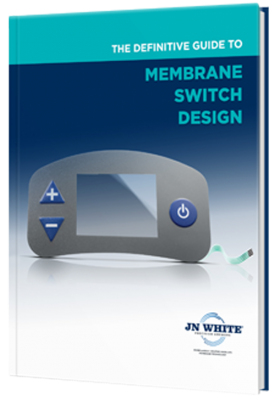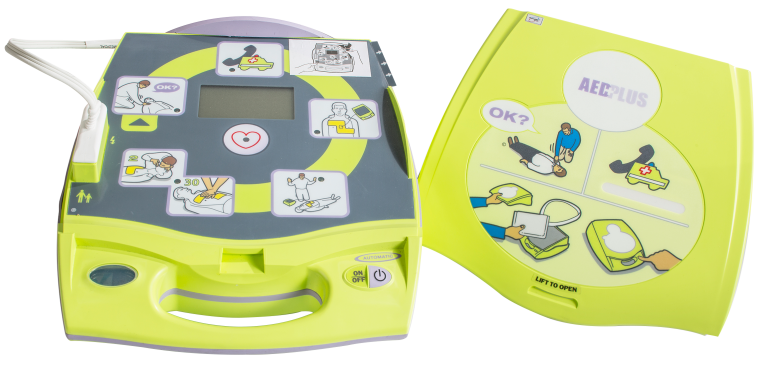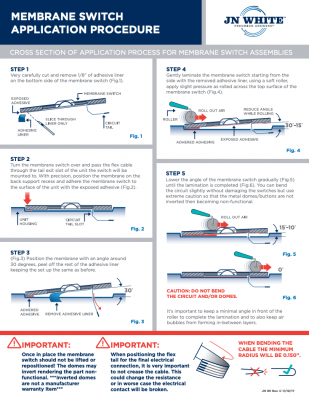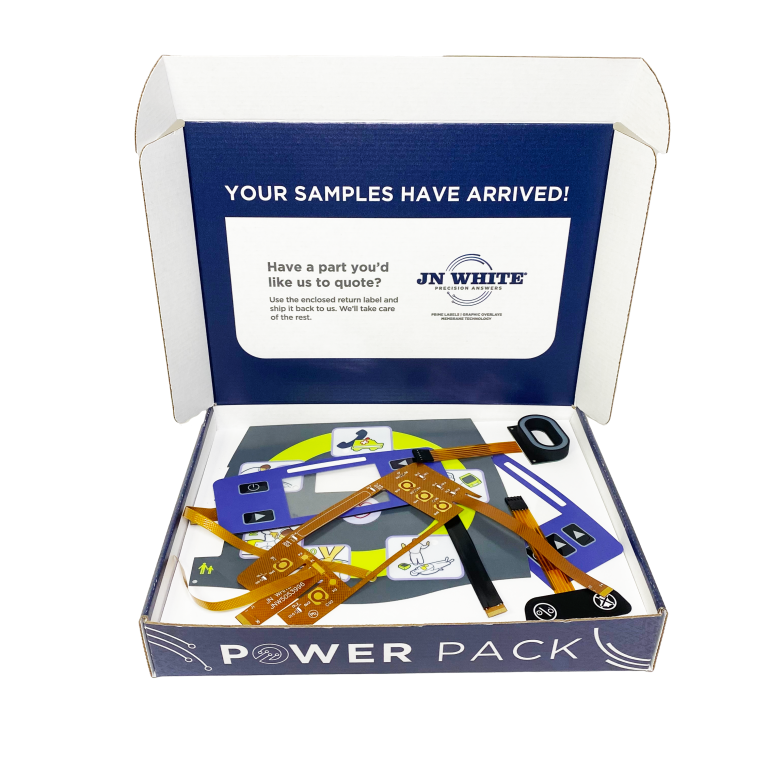Why Choose JN White® for Membrane Buttons?
At JN White®, we bring years of expertise as a trusted membrane button manufacturer, helping customers achieve their specific interface objectives. Whether you need tactile feedback, shielding, or touchscreen integration, our custom designs meet rigorous standards for durability and functionality in demanding environments.

What Are Membrane Buttons?
Membrane buttons are a type of momentary closure device used in applications requiring a thin, durable interface. They consist of flexible graphic and internal layers that sit over a printed circuit on PET or polyimide.
Engineers prefer membrane buttons and switches for their versatile, layered design, offering endless customization options. From tactile feedback to backlighting, they’re ideal for industries such as:
- Medical
- Consumer electronics
- Aerospace
- Military/DoD
Benefits of Membrane Buttons
- Durability: Built for long-term reliability in harsh environments.
- Customization: Wide options for materials, adhesives, and overlays.
- Compact Design: Streamlined assembly with embedded components like LEDs and sensors.
- User Experience: Enhanced with tactile and visual feedback options.
Components of Membrane Buttons
Graphic Overlays
This is the top layer and the main interface between the user and the machine. We use materials like polycarbonate or polyester for scratch resistance, chemical protection, and environmental durability.
Adhesives
Adhesives secure the graphic overlay to the switch and the entire assembly to your device. Proper selection ensures performance under environmental stress and extended usage.
Circuits
Circuits in membrane buttons can be made with silver conductive ink, etched copper flex, or PCB technology, depending on application needs.
Embossing Options
Choose from pillow, rim, or poly-dome embossing to enhance tactile feedback and aesthetic appeal.
Shielding
Electromagnetic (EMI), radio frequency (RFI), and electrostatic discharge (ESD) shielding ensure compliance with stringent industry requirements.
Touchscreen Integration
Integrating touchscreens with membrane buttons offers a compact, seamless user interface.

Design Your Own Membrane Switch

Constructions
Membrane Button Construction Options
Simple Membrane Buttons
The simplest designs feature three layers: a graphic overlay, circuit spacer, and silver-printed circuit. They are ideal for cost-effective, straightforward applications.
Complex Membrane Buttons
Multi-layered switches may include some form of ESD, EMI, or RFD shielding, embedded components like LED’s, resistors, light sensors and even programmable chips. To accommodate these more robust designs we are often using copper flex or PCB’s for the circuit layer. As a result the electronic options are virtually limitless.
Considerations for Simple Membrane Switch Constructions
Tactile vs Non-Tactile Feedback
Tactile feedback refers to the feel you experience when you push a button. By using different materials and sizes for these buttons, you can vary the actuation force required to activate the switch.
Tactile Switch with Silver Circuitry
Tactile switches incorporate a metal dome or a polydome into the membrane assembly to achieve a desired tactile (and sometimes audible) response. By using different materials and sizes for these domes, you can vary the actuation force required to activate the switch. Read About Tactile Switches >
Non-Tactile Switch with Silver Circuitry
Since there is no tactile feel when these circuits are actuated, there is often a sound or light component put in place to indicate activation. Depending on the device and the design, electronic shielding techniques may also need to be incorporated. Read About Non-Tactile Switches >
Considerations for Complex Membrane Switch Constructions
Copper Flex Membrane Switches
Unlike screen-printed silver, copper flex circuits are manufactured by laminating copper to an underlying substrate, and then etching that substrate in a way that leaves specific conductive traces, resulting in a more flexible, durable, and precise circuit that compounds can be soldered to. Read About Copper Flex Circuits >
Printed Circuit Boards (PCB’s)
Some user interfaces require higher-density, more miniature components. In these situations, printed circuit boards (PCB’s) and printed circuit board assemblies (PCBa’s) are often brought into play. Read About Printed Circuit Boards >
LED Backlighting Options
Designing the right backlighting technology into a switch assembly can help deliver a superior user experience. A wide variety of backlighting options are available, allowing engineers to precisely manage light quality, color, intensity, and coverage, so it is important that your selected switch manufacturer understands the advantages and disadvantages of these different techniques and how to properly incorporate them into a design. Read About Backlighting Technology >
Dead Front Display
When a clean aesthetic and emphasizing certain icons is important, dead front displays are utilized. Dead fronting is a term used to describe an icon that is typically hidden from view but is visible under certain circumstances. The dead front icon must be transparent and allow light to shine through, therefore illuminating the icon, while the surrounding overlay must remain opaque and undisturbed by the backlight. Read About Dead Front Displays >
Touchscreen Integration
Incorporating touchscreens into complex membrane switches requires a delicate balance between functionality, usability, and aesthetics. At JN White®, we excel in seamlessly integrating different types of touchscreens into your interface design. We understand the importance of selecting the right touchscreen technology and properly incorporating it into the overall assembly. Read About Touchscreens >
Visual Design Considerations
Digital printing, color management, inks, finishes, and embossing all dramatically enhance the look and function of a switch. At JN White®, we have a computerized color formulation system to achieve consistent results from piece to piece, as well as ones that can color match to the Pantone Matching System, Federal Standard Guide, a color swatch, or to your bezel. Read About Membrane Switch Color >
Environmental Considerations
Switches need to be reliable for years, all the while being used on a daily or even hourly basis. This requires an active and purposeful design for lifetime actuation. When building a switch, it’s important to consider the types of durability needed, material selection, and whether it needs to be weather sealed. Read About Environmental Considerations >
How To Install a Membrane Switch
Our resident switch expert, Ken Boss, shows you how to install a membrane switch onto your products. The full instructions can be seen below.

View Membrane Switch Application Procedure as PDF
Check Out Our New Power Pack Samples!

We have compiled a variety of our most versatile membrane switches and unique samples that you can feel and interact with, free of charge. See first-hand the quality, function and durability these highly customizable switches provide users. Request a Power Pack today!
Hear What Our Customers Say






